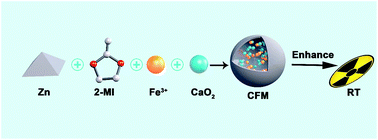Development of a novel oxidative stress-amplifying nanocomposite capable of supplying intratumoral H2O2 and O2 for enhanced chemodynamic therapy and radiotherapy in patient-derived xenograft (PDX) models†
Abstract
Radiotherapy (RT) is a potent approach to cancer treatment, but the tumor microenvironment (TME) in solid tumors is often highly hypoxic and contains high levels of antioxidant enzymes, thereby reducing the RT efficacy. In this study, we developed an oxidative stress amplifier (termed CFM) capable of self-sufficient H2O2 and O2 delivery that can be used in concert with RT and chemodynamic therapy (CDT) to treat tumors in patient-derived xenograft (PDX) model systems. Upon exposure to the hypoxic and acidic TME, CFM undergoes rapid degradation that results in the release of Fe3+, Ca2+, O2, and H2O2. Glutathione can subsequently reduce Fe3+ to Fe2+, which is then able to react with H2O2via the Fenton reaction to yield high levels of hydroxyl radicals which subsequently damage mitochondria. CaO2-derived O2 also modulates intratumoral hypoxia, while excessive Ca2+ levels within mitochondria result in apoptotic cell death. Altogether, these properties sensitize PDX tumors to RT. Importantly, the Fe, Zn, and Ca generated by CFM degradation are essential elements in humans. Altogether, these properties make this approach to oxidative stress amplification a promising means of amplifying oxidative stress within tumors while overcoming hypoxia-related resistance to RT, thereby providing a framework for the design of potent radiosensitizing therapeutic approaches.



 Please wait while we load your content...
Please wait while we load your content...